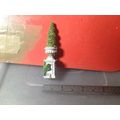Bird - Golden Eagle with chick - Stop poisioning campaign postcard c.2000
- Condition : Used
- Dispatch : 2 Days
- Brand : None
- ID# : 132404024
- Quantity : 1 item
- Views : 413
- Location : United Kingdom

- Seller : justthebook (+1699)
- Barcode : None
- Start : Sun 05 Oct 2014 08:20:45 (EDT)
- Close : Run Until Sold
- Remain : Run Until Sold
Checks/Cheques
 for 1 item(s) edit
for 1 item(s) edit
Shipping Calculator
More Listings from This Seller view all
Seller's Description
- Postcard
- Picture / Image: Golden Eagle (Aquila chrysaetos) with chick - Stop Illegal Poisioning campaign
- Publisher: Department of the Environment
- Postally used: no
- Stamp: n/a
- Postmark(s): n/a
- Sent to: n/a
- Notes / condition:
Please ask if you need any other information and I will do the best I can to answer.
Image may be low res for illustrative purposes - if you need a higher definition image then please contact me and I may be able to send one. No cards have been trimmed (unless stated).
------------------------------------------------
Postage & Packing:
Postage and packing charge should be showing for your location (contact if not sure).
No additional charges for more than one postcard. You can buy as many postcards from me as you like and you will just pay the fee above once. Please wait for combined invoice. (If buying postcards with other things such as books, please contact or wait for invoice before paying).
Payment Methods:
UK - PayPal, Cheque (from UK bank) or postal order
Outside UK: PayPal ONLY (unless otherwise stated) please. NO non-UK currency checks or money orders (sorry).
NOTE: All postcards are sent in brand new stiffened envelopes which I have bought for the task. These are specially made to protect postcards and you may be able to re-use them. In addition there are other costs to sending so the above charge is not just for the stamp!
I will give a full refund if you are not fully satisfied with the postcard.
----------------------------------------------
Text from the free encyclopedia WIKIPEDIA may appear below to give a little background information (internal links may not work) :
*************
The Golden Eagle (Aquila chrysaetos) is one of the best-known birds of prey in the Northern Hemisphere. It is the most widely distributed species of eagle. Like all eagles, it belongs to the family Accipitridae. These birds are dark brown, with lighter golden-brown plumage on their napes. Immature eagles of this species typically have white on the tail and often have white markings on the wings. Golden Eagles use their agility and speed combined with powerful feet and massive, sharp talons to snatch up a variety of prey (mainly hares, rabbits, marmots and other ground squirrels).[2]
Golden Eagles maintain home ranges or territories that may be as large as 200 km2 (77 sq mi). They build large nests in high places (mainly cliffs) to which they may return for several breeding years. Most breeding activities take place in the spring; they are monogamous and may remain together for several years or possibly for life. Females lay up to four eggs, and then incubate them for six weeks. Typically, one or two young survive to fledge in about three months. These juvenile Golden Eagles usually attain full independence in the fall, after which they wander widely until establishing a territory for themselves in four to five years.
Once widespread across the Holarctic, it has disappeared from many areas which are now more heavily populated by humans. Despite being extirpated from or uncommon in some its former range, the species is still fairly ubiquitous, being present in sizeable stretches of Eurasia, North America, and parts of North Africa. It is the largest and least populous of the five species of true accipitrid to occur as a breeding species in both the Palearctic and the Nearctic.[3]
For centuries, this species has been one of the most highly regarded birds used in falconry, with the Eurasian subspecies having been used to hunt and kill prey such as Gray Wolves (Canis lupus) in some native communities. Due to its hunting prowess, the Golden Eagle is regarded with great mystic reverence in some ancient, tribal cultures. The Golden Eagle is one of the most extensively studied species of raptor in the world in some parts of its range, such as the Western United States and the Western Palearctic.
The Golden Eagle is a very large, dark brown raptor with broad wings, ranging from 66 to 102 cm (26 to 40 in) in length and from 1.8 to 2.34 m (5 ft 11 in to 7 ft 8 in) in wingspan.[4][5][6][7] This species' wingspan is the fifth largest amongst extant eagle species.[5] In the largest race (A. c. daphanea) males and females weigh typically 4.05 kg (8.9 lb) and 6.35 kg (14.0 lb). In the smallest subspecies, A. c. japonica, males weigh 2.5 kg (5.5 lb) and females 3.25 kg (7.2 lb).[2] In the species overall, males may average around 3.6 kg (7.9 lb) and females around 5.1 kg (11 lb).[8] The maximum size of this species is a matter of some debate. Large races are the heaviest representatives of the Aquila genus and this species is on average the seventh-heaviest living eagle species. The Golden Eagle ranks as the second heaviest breeding eagle in North America, Europe and Africa but the fourth heaviest in Asia.[3][5] For some time, the largest known mass authenticated for a wild female was the specimen from the nominate race which weighed around 6.7 kg (15 lb) and spanned 2.55 m (8 ft 4 in) across the wings.[9] American Golden Eagles are typically somewhat smaller than the large Eurasian races, but a massive female that was banded and released in 2006 around Wyoming’s Bridger-Teton National Forest became the heaviest wild Golden Eagle on record, at 7.2 kg (16 lb).[10] No comprehensive range of weights are known for the largest subspecies (A. c. daphanea).[9] Captive birds have been measured up to a wingspan of 2.81 m (9 ft 3 in) and a mass of 12.1 kg (27 lb) (the latter figure was for an eagle bred for the purposes of falconry which tend to be unnaturally heavy), respectively.[9] The standard measurements of the species include a wing chord length of 52–72 cm (20–28 in), a tail length of 26.5–38 cm (10.4–15.0 in) and a tarsus length of 9.4–12.2 cm (3.7–4.8 in).[5] The culmen reportedly averages around 4.5 cm (1.8 in), with a range of 3.6 to 5 cm (1.4 to 2.0 in) and the bill length from the gape measures around 6 cm (2.4 in).[11][12] The long, straight and powerful hallux-claw (or hind claw, the equivalent to the big toe) can range from 4.5 to 6.34 cm (1.77 to 2.50 in), being about one centimeter more than the hallux-claw of a Bald Eagle (Haliaeetus leucocephalus) and a little more than one cm less than a Harpy Eagle (Harpia harpyja).[13][14][15] The sexes are similar in plumage but are considerably dimorphic in size. Females are rather larger than males with the differences increasing as the body size increases across the races. The large Himalayan Golden Eagles females are about 37% heavier and nearly 9% longer in wing length than the males of the race compared with the small Japanese Golden Eagles where females are a relatively modest 26% heavier and around 6% longer in wing length than males.[2][16]
Adults are primarily dark brown in color, with a paler, typically golden color (the source of the species’ common name) on the back of the crown and nape, and some grey on the inner-wing and tail.[17] There are subtle differences in coloration among the races, described below. Unlike in other Aquila species, where the tarsal feathers are typically of a similar color to the rest of the plumage, the tarsal feathers of Golden Eagles tend to be paler, ranging from light golden to white.[2] In addition, some full-grown birds (especially in North America) have white ""epaulettes"" on the upper part of each scapular feather tract.[3][18] The bill is dark at the tip, fading to a lighter horn color, with a yellow cere.[19] As in many acciptrids, the bare portion of the feet are yellow.[5] This species moults gradually beginning in March or April until September or October each year. Moulting usually decreases in winter. Moult of the contour feathers begins on the head and neck region and process along the feather tracts in a general anterior-posterior direction. Feathers on head, neck, back and scapulars may be replaced annually. With large feathers of the wing and tail, moult beginning with innermost feather and proceeds outwards in a straightforward manner known as ""descendant"" moult.[18]
The juvenile Golden Eagle is similar to the adult but tends to be darker, appearing black on the back especially in East Asia. Compared to adults, juveniles have a more unfaded color. Young birds are white for about two-thirds of their tail length ending with a broad, black terminal band.[16] Occasionally, juvenile eagles have white patches on the remiges at the bases of the inner primaries and the outer secondaries, forming a crescent marking on the wings which tend to be divided by darker feathers.[2][20] Rarely, juvenile birds may have only trace amounts of white on the tail. Compared to the relatively consistently white tail, the white patches on the wing are extremely variable and some juveniles have almost no white visible. Juveniles of less than 12 months of age tend to have the most extensive amount of white to the plumage.[18] By their second summer, the white underwing coverts are usually replaced by a characteristic rusty-brown color. By the third summer, the upper-wing coverts are largely replaced by dark brown feathers, however not all feathers moult at once giving many juvenile birds a grizzled pattern. The tail also follows a similar pattern of maturation.[18][20] Due to the amount of variability in different individuals, juvenile eagles cannot be reliably aged on sight alone.[21] Many Golden Eagles still have white on the tail during their first attempt at nesting.[22] The final adult plumage is not fully attained until the birds are between 5 and a half and 6 and a half years old.[21]
While many accipitrids are not known for their strong voices, Golden Eagles have a particular tendency for silence, even while breeding.[23] Some vocalization, however, has been recorded, and these normally are centering around the nesting period. The voice of the Golden Eagle is considered weak, high and shrill, even being emphatically described as “quite pathetic” and “puppy-like”, and as somewhat incongruous considering the formidable size and nature of the species.[5] Most known vocalization seem to function as contact calls between eagles, sometimes adults to their offspring, occasionally territorial birds to intruders and rarely between a breeding pair. In Western Montana, nine distinct calls were noted: a chirp, a seeir, a pssa, a skonk, a cluck, a wonk, a honk and a hiss.[24]
type=printed
animal subject=bird
period=post-war (1945-present)
postage condition=unposted
number of items=single
size=continental/ modern (150x100 mm)
Listing Information
| Listing Type | Gallery Listing |
| Listing ID# | 132404024 |
| Start Time | Sun 05 Oct 2014 08:20:45 (EDT) |
| Close Time | Run Until Sold |
| Starting Bid | Fixed Price (no bidding) |
| Item Condition | Used |
| Bids | 0 |
| Views | 413 |
| Dispatch Time | 2 Days |
| Quantity | 1 |
| Location | United Kingdom |
| Auto Extend | No |





















